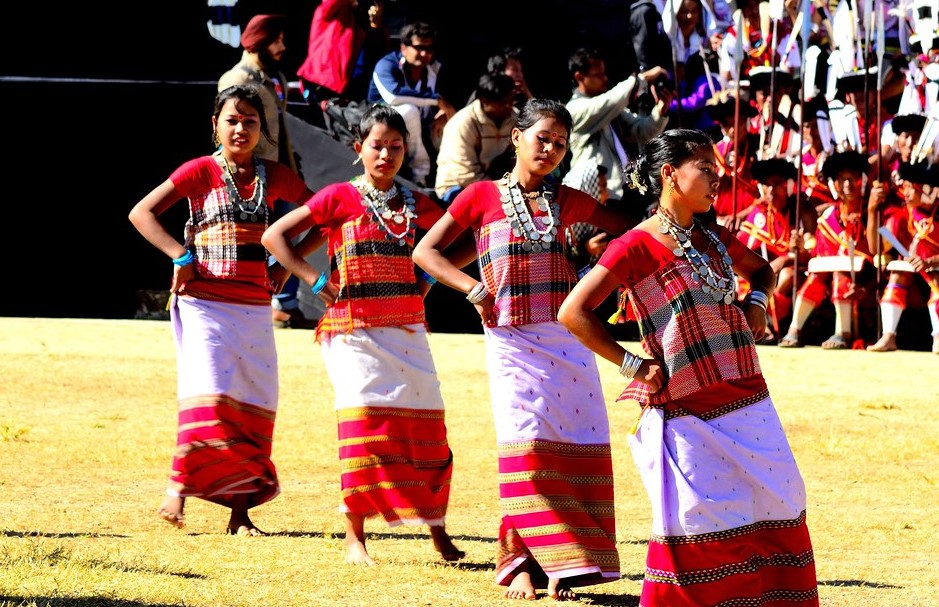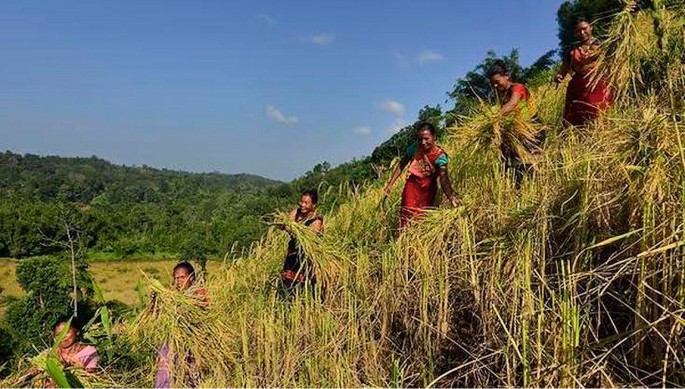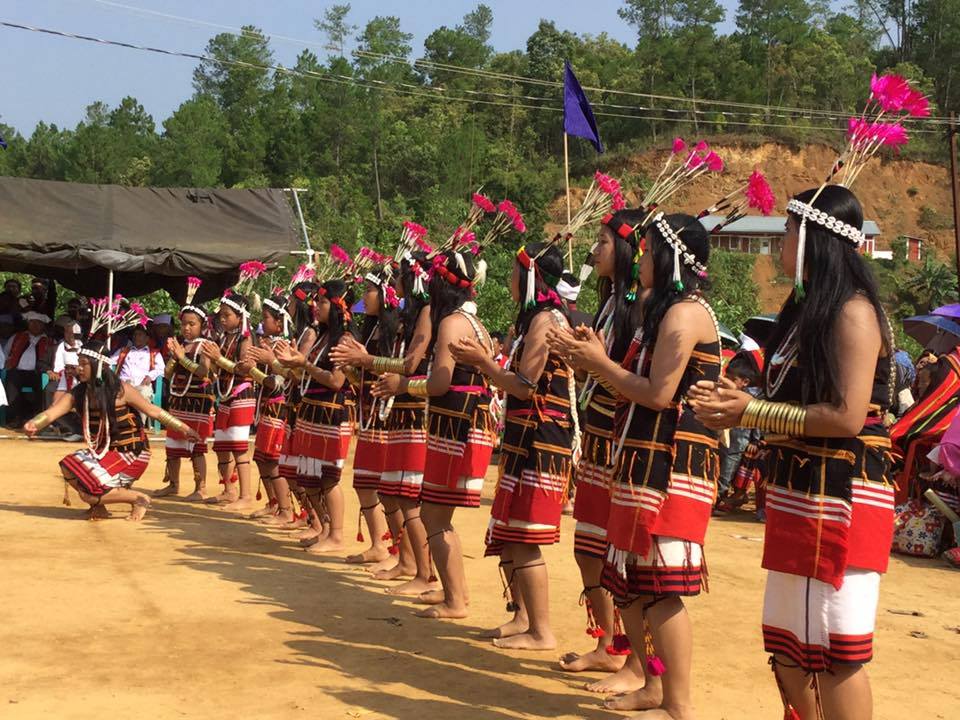Dr Milan Rani Jamatia
In every society, based on a set of beliefs and norms, rites come into being and by practicing them, people place them within the ambit of a definition called social customs. In Jamatia society, there are many social customs which are practiced widely on occasions ranging from a person’s birth to death. These customs not only play a key role in strengthening the solidarity between members of the community, but also shape a unique identity amongst a plethora of ethnic groups inhabiting the state of Tripura. In this article the birth rites practiced by the Jamatia tribes of the state will be specially elaborated.
As per beliefs, being born in this world as a human being is the greatest accomplishment of a person. This human life cannot be attained again and again and therefore the birth of a child is celebrated like a festival and each and every member of the family along with relatives as well as neighbours extend a warm and grand welcome to the new-born child. In the present times, upon the birth of a child, grandparents celebrate the arrival of the newborm by offering sweets and other food items to the family members and neighbours. In the past, they used to celebrate by throwing feasts with delicacies of chicken or mutton. Being patrilineal society, the Jamatias usually assigns the new born child with his or her father’s clan and caste. In jamatia society discrimination does not exist on the basis of the newborn child’s gender. Irrespective of it being a male or female, in both cases, he or she is brought up and nurtured in the same way. Jamatias consider it a sin for woman to bear child before entering into marriage. Such a child of an unmarried woman is referred to as Pha-Phoroi-Saa (illegitimate child) who may have to face humiliation for the rest of his/her life.The birth rites in Jamatia society are performed as follows Chorai Achaiya Sokang (before birth of a child)
During the pre-natal period, Jamatia women has to abide by certain rules based on norms and beliefs, for example:
a) They are restrained from being outside the house in the afternoon and evening as these are the times of the evil spirits and there is possibility of the child falling prey to evil eyes.
b) They are restrained from eating mirka fish because it is believed that eating the fish in that period can cause the child to suffer from epilepsy after birth.
c) They are advised to sleep with her head positioned towards the east or south, as only a deceased person lies with his or her head is positioned towards the north or west.
d) They are not supposed to look at solar or lunar eclipses because that may may spell unholy influence on the child to be born.
e) Their husbands are restricted from doing certain activities such as hunting. Doing so would create possibilities of mutilation of the body organs of the child Moreover, they are also forbidden to act as baruva, i.e., an assistant priest.
f) During pregnancy, a woman is not allowed to eat a fruit called ‘Aafi Phal-Fakra’, as eating this may cause her to bear twins, which may cause more trouble to her.
g) The pregnant women must perform Lampra Puja1 is after five months of conception with a view to safeguard herself from obstacles and difficulties etc. This puja is performed specially for well-being of the pregnant woman.
h) Apart from this, pregnant women are instructed to maintain balance in her behaviour and to take due care regarding hygiene.
Both men and women are allowed to do all kinds of household activities and take part in social or agricultural duties. Doing household works is considered good for the health of the woman during pregnancy. As per beliefs, if a woman continues doing regular chores, she would not have to go through much trouble during childbirth.
With the starting of labour pains, arrangements are made for the woman to stay in a separate house or a room and all her family members together take the responsibility of taking proper care of her.
Chorai Achaima (childbirth)
In jamatia society, woman folks welcome a new born child by ululating which is called jaga-lu in the local language. Although this tradition of ululation to mark the beginning of an auspicious work is an adaptation from Bengali society, it is difficult to conclude as to since when and how this tradition became a part of jamatia culture. In the present times, to mark the beginning of any auspicious event, such as a welcoming ceremony, prayer to the almighty, weddings, various festivals, birth of a child, pujas performed for well-being and protection of a family or a whole village, woman folks ululate in unison.
As soon as a woman expecting child starts having labour pains, a group of five-six woman are requested to assist her during childbirth. Soon after they arrive, it is decided by themselves who would be the kumajok2 and lakmajok3. Any woman in the village with experience of assisting childbearing can act as Kumajok and lakmajok. After the child is born, the umbilical cord is cut off and kept inside chhapra/chhapri (a basket).
It is called baduk and fa within jamatiya society. This act of cutting off the umbilical cord is performed using a vamtha, a sharp piece of bamboo. Meanwhile, the lakmajok arranges for hot water in which raw turmericmay also be added. The newbornchild and the mother are now bathed in lukewarm water after which the baby is handed over to the lakmajok (assistant daima) for further rituals. Lakmajok, with the baby in her lap, presses down a chopper knife on the ground stomps on the ground thrice by saying ‘amo aani onkha, aani onkha nono tei chong yakaliya’ which literally means ‘it is now mine, it’s mine, now we will not let you go anywhere’. Soon the other women present also add in unison ‘ein tabkale amo chini onkha, chini onkha’ (yes, now it is ours, it is ours). The lakmajok then declares whether the newborn child is a boy or a girl. Now this information is immediately conveyed to the father and other members of the family. Soon, two-three women stands on the courtyard and ululate in unison. Mentionable that it is restricted to tell whether the child is a boy or a girl before performing this ritual. Now, having the sal (sun), taal (moon), nakbar (wind), ha (earth), toybukma (water goddess) etc. as witnesses, the child is given a name by the kumajok (daima). This name is considered as the real name of the child which is kept secret and is not disclosed to anyone other than its parents. As per beliefs if the secret name of the child is disclosed to others, evil spirits cause harm to it.
After naming of the baby, the chapra/chapri (basket), in which the baduk and fa (pieces separated umbilical cord) were placed, is taken afar from human habitat and is buried, after which suchubocholoi is sprinkled around it. This is a mixture of small pieces of turmeric, mustard seeds and rice grains purified with mantras. After that women folks visit riverbanks or ponds to bathe and come back to the house of the newborn child. Soon after they return, lakmajok (assistant daima) ties black threads to the hands and feet of infant and sprinkles suchubocholoi around the corners of the house. Wishing for good health to the mother, a fire is lit in which suchubocholoi is sprinkled.
The fire is kept burning until the amthai or the cord stump falls off child. Even dumping of the ashes outside is restricted as well. A little amount of suchubocholoi is also tied inside a cloth which is placed under headrest or pillow used by the newborn child. This is done to protect the mother and her child from the evil eyes and evil spirits.
After birth of a child, parents are required to stay separately for a period of time. The mother is considered abur or polluted at that time and is restricted from entering the kitchen and other rooms, especially where gods and goddesses are installed. Other members of the family may enter the maternity room, but the males usually refrain from this. During the period separate dining arrangements are made for the mother and all female members of the family take this responsibility. Noteworthy that the kumazok-lakmazok (daima-assistant daima) are also considered polluted during this period. This continues until the child’s amthai or cord stump does not fall off.
Amthai Kakma (breaking of relationship)
The kumajok and lakmajok are invited again soon after the amthai or the cord stump falls off the child’s body. Now the mother puts all the ashes and the cord stump inside a chapra/chapri (basket) and buries it in the forest far away from human habitation. Before burying, the ground is cleaned properly and as per beliefs, this ritual protects the child from itching etc., ensuring good health. After that, suchubocholoi is sprinkled around the place. All these rituals are performed by the mother and the kumajok-lakmazok assists her. After this everyone returns home.
That day the house is cleaned properly. All the clothes of the mother are washed and from now on she is not required to stay inside the temporary maternity room and is able to share other rooms of the house. However, she is still restricted from entering the kitchen, but at the same time she is allowed to provide a helping hand in the household chores such as, cooking for herself, collecting water, washing clothes etc. asper her abilities. Kumajok and lakmajok are now free from pollution following childbirth. Until this ritual is performed, they are also restricted from entering other people’s houses, and even if they enter other’s house following urgency, they are still not allowed step inside the main rooms and the kitchen.
Lampra Puja
As the amthai or cord stump fell off the child’s naval following which it is buried and the whole house is cleaned properly, it is now time to perform Lampra Puja through achai4. This puja is formed not only for good health of the mother and her child, but also for purification of the house. On that day the child looks at the sun for the first time and this ritual is called chorai nakhla karma in jamatiya society. From this day onwards, it is allowed to take the child to other places as well. It is important to note that before performing this lampra puja, it is considered inauspicious to bring the child out of maternity room and therefore restricted.
Abur Suma / Chorai Ha Karma (Annaprashan)
After birth of a child, this rite is the final and very important. It is performed taking into consideration that the mother is completely healthy. The child’s father or any other understanding member of the family visits the achai (priest) with offerings of turmeric, handful of rice and rice beer in a Wathoi bamboo.
He informs the achai in detail about the health of the mother and her child and further requests him / her to perform this rite. This tradition is referred to as achaibatema.As a date is fixed to perform the rite, their house is cleaned properly. On that day, on behalf of child, the achai worships toysokal (water goddess) by sacrificing a goat and a feast is thrown at the child’s home. Relatives and neighbours attend the feast and bless the child. Kumajuk and lakmajok are specially invited because the ceremony is incomplete without their presence. The house is purified by sprinkling holy water after the conducting the worship of toysokal or the water goddess. In the meantime, the child is bathed and dressed in new clothes and the mother also gets ready. After worshipping the river goddess, the achai invokes the sun, moon, wind, earth and fourteen deities in the courtyard and prays before all these deities to bless the child and the mother. After this the mother and child are asked to come out and seek blessings from the achai. But before the child is brought outside, the kumajokworships the doorway, arrowsare shot four times after looking towards the north, south, the earth and the sky.A flare is lit up and is pointed towards all the four corners after which the child is brought outside the house. This is done to keep away evil spirits. With great fervour and enthusiasm,everyone accords a hearty welcome to the child. This is the first time that the child’s feet touch the ground after birth. Now the feet of the child are purified with holy water and the achaiblesses both the child and mother, wishes them good health and long lives. Now the child is brought to the Kumajuk and lakmajok
HanjokKasma / KanyaAtak
As soon as everyone enters the house after performing rituals outside, other relatives stop them at the doorway by obstructing with a Wathoi5 bamboo. This tradition is called hanjokkasma or kanyaatakand it is customary to enter inside by offering a bottle of rice beer. Nowadays money is given instead. As they go inside, the lakmajokarranges a plate decorated with raw turmeric, durvagrass, cotton, chopper knife, ha (soil) and halang (grinding pestle). The kumajok takes the child on his lap and blesses him/her by touching his/her forehead with each object. All the objects mentioned has different significance, for example, turmeric symbolises purity, chastity and colours of life, durvagrass symbolises wealth. Cotton is symbolic of shine and experience,chopper knife translates to diligence, activeness, strength and courage. Hai.e., soil) is regarded a symbol of generosity, vastness, tolerance etc. Halang or the grinding pestle renders profoundness, determination and strong personality. The kumajok blesses both the mother and the child and wishes that they live long and that the child develops all the abovementioned qualities.
Kumajok and lakmajok ceremoniously serves the newborn child with all the delicacies prepared on that day and the child is given a name again in presence of all relatives and villagers who enjoy the feast arranged as part of the ceremony and blessboth the mother and her child. A barber cuts and trims the newborn child’s nails and hair. In the end, the kumajok, lakmajok and achai are gifted new clothes along with a bottle of rice beer each and this practice is referred to as achai and kumajok-lakmajok mama. This ceremony may be held on that day or on any other auspicious day. As all of these are performed accordingly, birth rites are usually considered to be over in jamatia society.
Bibliography
1. ‘Modernity in Tradition: A Historical Study of the Jamatia Tribe of Tripura’: Dr K.B. Jamatia, Akshar Publications, Agartala, 2007
2. ‘Tripura Adivasi’: Naresh Chandra Debbarma, Kumud Kundu Choudhury and Biman Dhar, Tripura Darpan Prakashan, Agartala, 2009
3. Bhattacharjee, Dr P.N., Jamatia Folklore: A Sociological Study, Tribal Research Institute, Agartala, 1997
4. Jamatia, Ratna Kishore, Bachabaisidi, Language Wing, T.T.A.A.D.C., Khumulwng, 2014
5. Jamatia, Padmalochan, Jamatia Loksanskriti, Nava Chandana Prakashani, 2015
6. Sri Kirit Kishore Jamatia Kothar Chibroi Motai Bai Wathoi Phang Raja (Fourteen deities and Wathoi Bamboo), Unpublished Article
(The author of this article is serving as an Assistant Professor in the Dept. of Hindi, Tripura University and can be reached at Mobile No. 8974009245)






